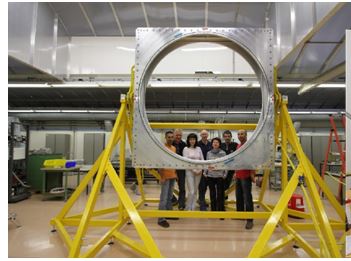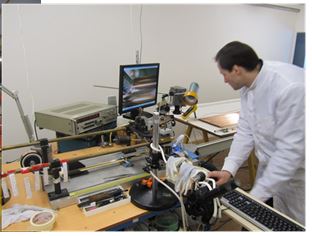NA62 – Searching for the Very Rare
Work is progressing swiftly on the construction of the new NA62 detectors. The experiment aims to collect new data, with a partial setup, already in 2012. NA62 is an experiment devoted to the study of rare kaon decays. It addresses in particular the very rare decay of a charged kaon into a pion and a neutrino-‐antineutrino pair, which is very elusive. The interest stems from the high degree of precision to which this decay is predicted in the Standard Model (SM). The decay is a so called Flavour Changing Neutral Current which is very much suppressed in the SM and sensitive to new short distance interactions. So far, the study of these decays has been performed using kaon decays at rest. NA62 has been designed to perform the study with decays in flight by collecting decays from a high momentum secondary beam produced by 400 GeV/c protons, extracted from the SPS, impinging on a beryllium target. NA62 will be housed in the North Area High Intensity Facility (NAHIF) which hosted the predecessor experiment NA48. The new beam and detectors will occupy a 270 m long region and useful kaon decays will be collected from a 65 m long fiducial volume. The refurbishment of the experimental cavern and the construction of the new beam line are progressing efficiently under the responsibility of the CERN EN-‐MEF group.
The NA62 detectors have to tackle four main challenges:
1. Tracking with a low mass detector under extreme rate conditions
Although only 6% of the incoming beam particles are kaons and just 10% of them decay usefully in the 65 m long fiducial region, all of them have to be tracked on an event by event basis. To accumulate about 1013useful kaon decays, the incoming beam intensity approaches 1 GHz. All the beam particles cross the silicon micropixel beam detector aptly called “Gigatracker”. To select the incoming kaon and correlate it with the decay in the downstream detectors, the Gigatracker requires, in addition to very low mass and good position resolution, also unprecedented time resolution for this type of detectors. Prototype Gigatracker detectors were tested in 2010 at the PS East Area, the R.M.S. of the time resolution with beam particles was measured to be better than 200 ps per detector, completely fulfilling the NA62 specifications. The heart of the Gigatracker resides in the ASIC chip, which is currently being designed by the PH-‐ESE group at CERN. Another notable feature is represented by the requirement of low material mass on the beam line in order to minimize inelastic interactions. This imposes tight requirements on the processing of the assemblies and the cooling system. A totally novel cooling technique, based on micro-‐channels, is being developed in the CERN PH-‐DT group in Collaboration with EPFL and it might provide an elegant and uniform cooling solution. Cooling is very important in order to mitigate the effects of radiation damage. Groups from Belgium, Italy and CERN collaborate to build the Gigatracker.
2. Tracking with ultra-‐low mass detector over a large surface
Once the kaon has decayed in the vacuum tank, the outgoing charged pion has to be tracked making sure that the measurement is disturbed by a minimal amount of multiple scattering. To do so, a Straw tracker was developed by the CERN PH-‐DT group in collaboration with JINR. The straw tubes will be operated directly in thevacuum tank.
Requirements on these chambers are very stringent since the gas permeation has to be limited in order to preserve the quality of the vacuum in the decay tank to avoid inelastic interactions of the beam particles. A new way of manufacturing straws was developed in order to produce a detector with as littlematerial as possible. An innovative FPGA-‐based TDC readout is being developed in PH‐ESE. Assembly for the first half chamber has started and one expects three to four modules to be available by the time of the Technical Run in 2012.


First NA62 Straw Chamber frame ready for assembly at CERN and Straw manufacturing in JINR.
3. Photon Detection
Possibly the biggest challenge in NA62 is the suppression of thos frequent Kaon decays with photons like K+ -> π-π followed by the nstantaneous decay π+->γγ . In addition to the excellent tracking described above, essential to reject the two body kaon decays it is crucial to veto as mush as possible kaon decays with π and photons. If these particles would be left undetected, a mundane decay could mimic a signal candidate. In the forward region, the NA62 acceptance will be covered by 20 tons of liquid krypton, the former NA48 electro-magnetic calorimeter. Its read-out eletronics will be upgraded, tendering for the new equipment is imminent (followed by PH-ESE). The decay tank itself will be surrounded by 12 stations of lead glass calorimeter (LAV) made of blocks originally built for the OPAL detector at LEP. Based on measurements made with NA48 and test beas data, the overl π* suppression is expected to be about 108 . The LAV modeuls are under the responsibility of the italian INFN while two small angle detectors are provided by Bulgaria. Currently five LAV stations have already been built and most of the photon veto system is expeted to be installed by the end of next year.
4. Particle Identification
Last but not least,complete particle identification for the incoming beam particle and the decay one has to be provided.A differential Cherenkov (CEDAR) will be installed on the beam line and tuned to be blind to all particles but kaons. The hig rates require new photo-‐detectors and electronics (under UK responsibility).On the downstream side, a Ring Imaging Cherenkov Counter (RICH), read out by about 2000 photomultipliers will efficiently distinguish pion from muons up to large particle momenta (approx.35 GeV/c). full length(17 m) NA62 RICH prototype was built and tested with beams in 2007 and 2009 to demonstrate its unprecedented capability (17 m focal length, 17 m long neon radiator at atmospheric pressure).
All the RICH photomultipliers as well as the glass mirrors have already been procured by INFN. Further suppression of electrons and muons will be provided by muon vetoes and calorimeters.
Particularly crucial at the trigger level is the suppression of the muons from kaon decays and beam halo: a very fast muon veto plane has been specifically designed for this purpose.
The muon detector is a joint responsibility of IHEP Protvino, INR Moscow and Mainz.
Needless to say, preparations on the Trigger, Data Acquisition and Software are necessary and the Collaboration works hectically preparing for a Technical Run from September 2012.
More information on NA62 can be found in the publicly available Technical Design (NA62-, December 2010).
http://na62.web.cern.ch/NA62/Documents/TechnicalDesign.html
The Collaboration acknowledges the strong support provided by CERN and thanks in particular the Support and Technical teams from EN, PH and TE Departments.
